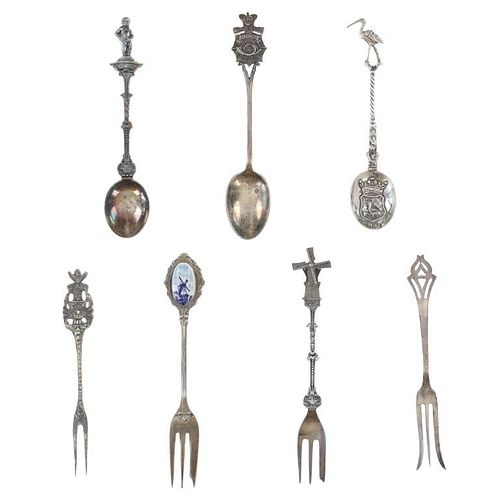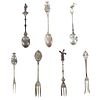Featured in this lot is a collection of various decorative sterling forks and spoons from Europe circa 1800-1900s. The collection includes four forks and three spoons. The first spoon was made in Birmingham, England for Halifax Rifles in Canada circa 1932. Halifax, Nova Scotia, is home to the Canadian militia group known as the Halifax Rifles. The Halifax Volunteer Battalion of Rifles—officially known as the Halifax Rifles—was established on October 8, 1860. It was created in response to the rising hostilities between the United States and Britain at the time, as well as the potential threat of American annexation of British North American territories. During the Fenian Raids, a series of incursions by the Irish-American nationalist organization Fenian Brotherhood into Canadian territory, the Halifax Rifles took part in defending Canada. Both 1866 and 1870 saw these raids. The Halifax Rifles participated in World War I actively, like many other Canadian military units. They dispatched troops to fight in the Western Front and other European theaters with the Canadian Expeditionary Force. The unit's contributions to this war were recognized with several battle honors. The Halifax Rifles continued to serve as a militia unit during the interwar years, providing neighborhood defense and emergency training. During this time, the unit underwent a number of reorganizations and modifications. The Halifax Rifles continued to serve as a militia unit after World War II, taking part in training drills and assisting civil authorities in times of need and during natural disasters. Additionally, the unit has participated in a number of international peacekeeping operations. Today, the Halifax Rifles remain an active militia unit, contributing to the Canadian Armed Forces' reserve component. The spoon shows a highly decorated handle reading, "Halifax Rifles / Cede Nullis (Yield To None) / Canada 63". The bottom of the bowl shows British stampings and makers mark reading "L & S" for L. Spiers, the Birmingham town mark, the lion passant indicating the quality of silver and the letter "O" for the date it was made (1932). The spoon shows good condition overall with a patina from its antique age, but no signs of obvious damage are present. The spoon measures 5 1/16" L x 1" W x 1/4" H. The second spoon was made in Brussels, Belgium circa late 1870-1900. The spoon is stamped on the back but is illegible. The handle is highly decorated and shows a small sculpture of a man at the top of the handle. Below the sculpture it reads, "Bruxelles", showing it was made in Brussels, Belgium. The spoon shows a patina from its antique age but no signs of obvious damage are present. The spoon measures 4 7/8" L x 1" W x 1/4" H. The third spoon features a sterling construction and shows detailed decorations of a crane and a family crest in the bowl of the spoon. The bowl of the spoon shows a family crest with "Hage" inscribed underneath it. The neck shows a partial twist with the crane sitting at the top. The spoon shows good condition overall with some wear from its antique age and use over the years but no obvious signs of damage are present. The spoon measures 4 11/16" L x 1" W x 1/4" H. The first fork in this collection is a thin, two prong fork with a highly decorated handle and neck. The top of the handle shows a windmill facing the viewer head on, with intricate designs below it. The back of the neck is marked, "8305". The fork shows some slight wear and a light patina from use and its antique age, but no signs of obvious damage are present. The fork measures 4 1/2" L x 11/16" W. The second is a simple, three prong sterling fork with a cut handle. The back of the neck features stampings reading, "Sterling N & H". The fork shows some slight wear from its antique age and warm patina to the sterling but no signs of obvious damage is present. The fork measures 4 11/16" L x 11/16" W. The third fork in this collection shows a simple three prong design with a souvenir fork style handle showing a painted windmill in blue coloring against a white background. The spoon shows no markings. The fork shows good condition overall with no signs of obvious damage present. The fork measures 5 1/8" L x 7/8" W. The final fork in this collection is constructed of sterling silver and shows intricate designs through the neck and handle. The top of the handle shows a detailed windmill made of sterling. The wings of the windmill spin freely when moved. The neck of the fork shows high detail in its designs, while the back shows a makers hallmark reading "HH" and other unidentifiable stampings. The fork shows good condition overall with slight wear from its age and use through the years. No obvious signs of damage are noted. The fork measures 5 1/8" L x 13/16" W. The collective weight of these items is 99.9 grams.

















